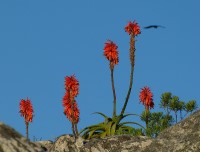News
- Details
- Category: News
 With the International Climate Protection Fellowships, the Alexander von Humboldt Foundation enables prospective leaders in academia and industry to implement a research based proposal in the field of climate protection or climate-related resource conservation during a one-year stay in Germany. The closing date for applications is 1 March 2019.
With the International Climate Protection Fellowships, the Alexander von Humboldt Foundation enables prospective leaders in academia and industry to implement a research based proposal in the field of climate protection or climate-related resource conservation during a one-year stay in Germany. The closing date for applications is 1 March 2019.Up to 20 International Climate Protection Fellowships are granted annually, funded under the German Federal Ministry for the Environment, Nature Conservation and Nuclear Safety’s (BMU) International Climate Initiative. The fellowships target prospective leaders from non-European transition and developing countries (see list of countries). Candidates draw up their own research-based proposal which they then implement in collaboration with a host in Germany.
- Details
- Category: News
 Taking place in Vienna, Austria 7–12 April 2019, the EGU 2019 General Assembly will bring together geoscientists from all over the world to explore all disciplines of the Earth, planetary, and space sciences. This year, there are a number of exciting, mountain-related sessions – including several led by the MRI.
Taking place in Vienna, Austria 7–12 April 2019, the EGU 2019 General Assembly will bring together geoscientists from all over the world to explore all disciplines of the Earth, planetary, and space sciences. This year, there are a number of exciting, mountain-related sessions – including several led by the MRI.The EGU aims to provide a forum where scientists, especially early-career researchers, can present their work and discuss their ideas with experts in all fields of geoscience. Abstract submissions are now invited for all sessions, including those being convened by representatives from the MRI. The deadline for abstract submission is 10 January 2019.
- Details
- Category: MRI News
A new Issue Brief highlighting the need to localize the United Nations Sustainable Development Goals for the resilience of mountain people and ecosystems was released today, 24 October, at the World Mountain Forum 2018 in Bishkek, Kyrgyzstan. This publication was developed by the MRI and the Center for Development and Environment as part of our collaboration on the Sustainable Mountain Development for Global Change (SMD4GC) programme.
Pledging to “leave no one behind,” the United Nations 2030 Agenda and Sustainable Development Goals (SDGs) have major potential to advance sustainable mountain development and strengthen the resilience of communities and ecosystems in mountain areas. But to realize that potential, the SDGs must be translated – or localized – to mountain areas. This will enable policymakers and implementers at the local, national, regional, and global levels to understand mountain priorities, customize actions, and measure progress towards the SDGs.
- Details
- Category: News
 A new study provides insights into water balance and evaporation losses in tropical alpine glacial lakes, which can serve as baseline information for future isotope‐based hydro‐climate research in high‐elevation regions in the tropics and elsewhere.
A new study provides insights into water balance and evaporation losses in tropical alpine glacial lakes, which can serve as baseline information for future isotope‐based hydro‐climate research in high‐elevation regions in the tropics and elsewhere.Tropical high‐elevation lakes are considered sentinels of global climate change. This work characterizes the hydrological conditions of tropical alpine glacial lakes located in the highlands of Chirripó, Costa Rica, using a unique data set of water stable isotopes (δ2H and δ18O) in precipitation, stream water, and lake water between September 2015 and July 2017.
A combined dataset of bathymetric, hydrometric, and isotope data collected between July 2016 and July 2017 on Lake Ditkevi was used to calculate the annual water balance of the lake. Evaporation to inflow ratios from three lake systems was estimated using a linear resistance model, the experimentally estimated local evaporation line of Chirripó, and the first glacial lake water evaporation lines in the region.
- Details
- Category: News
 IPBES is calling for experts with relevant knowledge and/or experience to participate in the assessment of invasive alien species. All governments and relevant organizations or institutions are encouraged to submit nominations.
IPBES is calling for experts with relevant knowledge and/or experience to participate in the assessment of invasive alien species. All governments and relevant organizations or institutions are encouraged to submit nominations.Nominees should have expertise related to the themes and skills required for the chapters of the assessment as set out in its scoping document (available here). They should be experts on invasive alien species within one or more of the following disciplines: natural sciences; social sciences; or the humanities; be indigenous and local knowledge experts, or have expertise in indigenous and local knowledge systems; or be policy experts and practitioners. All nominees should have experience in working within interdisciplinary and/or international contexts.
- Details
- Category: News
 A new paper published in the journal Biodiversity and Conservation models the current and future ranges of montane plant species in South Africa and Lesotho - and finds a contraction in species ranges towards higher elevation in response to climate warming.
A new paper published in the journal Biodiversity and Conservation models the current and future ranges of montane plant species in South Africa and Lesotho - and finds a contraction in species ranges towards higher elevation in response to climate warming. The modelled responses of plants used in this study show a decline in potential distribution as climate changes, and therefore suggest potentially increased vulnerability. This is a cause for concern for these southern African regions which are high in biodiversity and endemism.
- Details
- Category: News
 While temperatures in the tropical forests of northeastern Puerto Rico have climbed two degrees Celsius since the mid-1970s, the biomass of arthropods – invertebrate animals such as insects, millipedes, and sowbugs – has declined by as much as 60-fold, according to new findings published in the Proceedings of the National Academy of Sciences.
While temperatures in the tropical forests of northeastern Puerto Rico have climbed two degrees Celsius since the mid-1970s, the biomass of arthropods – invertebrate animals such as insects, millipedes, and sowbugs – has declined by as much as 60-fold, according to new findings published in the Proceedings of the National Academy of Sciences.The finding supports the recent United Nations Intergovernmental Panel on Climate Change warnings of severe environmental threats given a 2.0 degree Celsius elevation in global temperature. Like some other tropical locations, the study area in the Luquillo rainforest has already reached or exceeded a 2.0 degree Celsius rise in average temperature, and the study finds that the consequences are potentially catastrophic.
- Details
- Category: News
 Water-stable isotopic (WSI) data is widely used in hydrological modelling investigations. However, the long-term monitoring of these tracers at high-temporal resolution (sub-hourly) remains challenging due to technical and financial limitations. Thus, alternative tracers that allow continuous high-frequency monitoring for identifying fast-occurring hydrological processes via numerical simulations are needed.
Water-stable isotopic (WSI) data is widely used in hydrological modelling investigations. However, the long-term monitoring of these tracers at high-temporal resolution (sub-hourly) remains challenging due to technical and financial limitations. Thus, alternative tracers that allow continuous high-frequency monitoring for identifying fast-occurring hydrological processes via numerical simulations are needed. This study used a flexible numerical flow-partitioning model (TraSPAN) that simulates tracer mass balance and water flux response to investigate the relative contributions of event (new) and pre-event (old) water fractions to total runoff. Four TraSPAN structures were tested that represent different hydrological functioning to simulate storm flow partitioning for an event in a headwater forested temperate catchment in Western Oregon, USA using four-hour WSI and 0.25-h electrical conductivity (EC) data.







